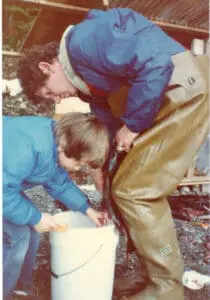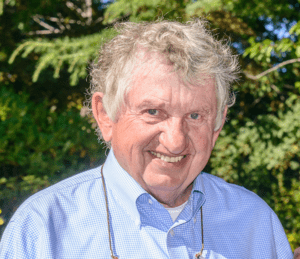
A History of Thinking Big
Fishers disagree about a lot of things, but they all find common ground around the fact that salmon and steelhead populations have faced a disastrous decline. In 1986, a group of salmon enthusiasts came together around this commonality and asked a question they intended to answer: could hatcheries be used to recover salmon and steelhead populations facing extinction? Current perspectives on the efficacy of hatcheries aside, at that time, this was a bold, genuine, and passionate attempt to save a priceless species and pastime for generations to come. This act marked the beginning of a more than 30-year quest to restore wild salmon and steelhead populations through an innovative nonprofit, Long Live the Kings.

LLTK founder, Jim Youngren, and his son at Glenwood Springs on Orcas Island
In 1978, Jim Youngren, a real estate entrepreneur born with a rod and reel in his hands, started raising Chinook salmon in natural ponds on his Orcas Island property, isolated from wild salmon populations which only spawn on the mainland. When asked about Jim’s success building a hatchery, his wife, Kathy Youngren, said “He dreamed it and here it is… he never ever for a second thought that this whole thing wouldn’t turn out just exactly how it has.” Jim’s think-big and make-it-work attitude has helped supplement sport and commercial fisheries from Washington to Alaska in a sustainable manner. Shortly after LLTK took over operations of the hatchery in 1986, the organization began operating two additional hatcheries: one on Wishkah River near Grays Harbor and another on Lilliwaup Creek along Hood Canal. These facilities embodied Jim’s vision by developing innovative techniques that mitigate the negative impacts of hatchery rearing on wild fish populations, and using those techniques to bring wild populations back from the brink of extinction. In Lilliwaup Creek and the Hamma Hamma River, LLTK has worked with other partners to rebuild the annual returning summer chum population from the hundreds to thousands, and have doubled the abundance of some steelhead populations.
In 1999, Congress created the Puget Sound and Coastal Washington Hatchery Reform Project, a groundbreaking effort to rethink how hatcheries can be managed to both conserve naturally spawning populations and support sustainable fisheries. With LLTK’s on-the-ground experience, Congress designated the organization as the project’s independent, third-party facilitator. The result was a comprehensive review of 200 hatchery programs, providing over 1,000 recommendations to improve their operations. This project created a paradigm shift in how hatcheries are managed in the Pacific Northwest. One of the most recognizable outcomes in Washington State has been the mass marking of nearly all hatchery fish—the removal of adipose fins–in order to easily distinguish them from wild fish. A majority of hatcheries in Washington have also instituted a series of changes to reduce the genetic impact that hatchery fish may have on wild populations.

LLTK founder, Jim Youngren.
As LLTK matured and grew as an organization, Jim’s example of bold thinking continued to influence decision-making. In 2014, LLTK and our Canadian partners, the Pacific Salmon Foundation, established the Salish Sea Marine Survival Project, a massive international endeavor to investigate the decline of salmon and steelhead populations in the combined waters of the Puget Sound, Strait of Georgia, and Strait of Juan de Fuca. Together, LLTK and PSF coordinate the efforts of over 60 organizations, producing research findings that are critical to saving salmon and steelhead populations threatened by extinction. Martha Kongsgaard, former chair of the Puget Sound Partnership, explains the importance of the work, “unraveling this mystery could provide answers for how to save the entire Sound.” The project, now in its third year, has mobilized over 150 scientists, established more than 80 research sites, and raised $17.5 million.
Building on the Salish Sea Marine Survival work, LLTK took on another huge challenge at the Hood Canal Bridge, the third largest floating bridge in the world. Research revealed that juvenile steelhead are dying at the bridge and that the bridge may also be effecting the canal’s water quality. LLTK has gained significant community support to address the problem by working with a team of experts to pin point how exactly the bridge may be impacting the ecosystem in order to implement solutions. It’s uncommon for a small nonprofit to attempt to address a problem involving such an enormous piece of vital infrastructure, but Jim wouldn’t back down from important challenges and neither will LLTK.
Most recently, LLTK has taken on a new challenge, launching a bold, new digital communications campaign in partnership with Paul G. Allen’s Vulcan, Inc. to bring awareness and investment to salmon and steelhead recovery. The Survive the Sound campaign allows people to connect with the wild steelhead, a species vitally important to our ecosystem and Northwest culture. By presenting the campaign as a web app, LLTK is looking to educate the next generation about the plight of salmon and steelhead by giving everyone an opportunity to sponsor and track a fish as it races to the Pacific Ocean. In its first year, the campaign is already generating important conversations in the community and catalyzing dormant salmon enthusiasts.
Thirty years of work, 1 million fish returned, over 250 partners, and more than 125 project sites: who knows if any of it would have happened without the organization’s bold, can-do thinking that Jim inspired.
LLTK will honor Jim at an annual benefit dinner, Salish Stories, on April 20th. If you would like to participate, please register here by April 15th.